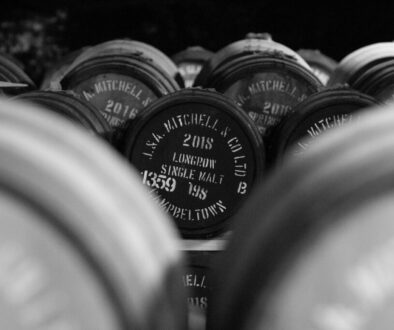
Toasting & Charring The Cask & What it Means for Your Whisky
So far, we have looked at how the type of wood and what the cask held before may influence your whisky. The next thing that may influence your whisky is the amount of charring that is applied to the inside of the barrel.
When a cask is constructed, at a very minimum it has to be toasted. This is done by placing the barrel over a relatively light flame to seal the wood. This has to be done to every barrel as it stops the natural saps interfering with the liquid stored in the cask. In the case of wine, beer and cider, this is usually as much that needs to be done. However, Bourbon also requires the cask to be charred.
Charring is when the cask is subjected to a more intense flame for a short period of time. This gives a charcoal layer on the inside of the cask that often looks like an alligator skin and has a few purposes.
The main purpose is that charring opens up the wood and the uneven surface increases surface area within the cask for the spirit to react with. The charcoal works as a subtle filter in the cask, removing unwanted compounds like sulphur which can be created during the distillation process. Additionally charring alters compounds found in the oak so the char also influences the colour and flavour of the whisky while it matures over several years.
The compounds in oak casks
The oak contains 4 main compounds that will have a part to play in the flavour of our whisky; hemicellulose, lignin, tannins and lactones. When subjected to heat, hemicellulose starts to break down into wood sugars which caramelise on the inside of the cask, giving sweet flavours such as toffee or caramel. Lignin is responsible for vanilla flavours within the spirit, and is responsible for more woody and spicy notes as the char is increased. Oak lactones are commonly associated with woody and coconut flavours but their effect is lessened as the char increases.
Lastly, the compound that most people will be familiar with is tannins. Present in everything from tea to red wine, they are also present in whisky. The amount of tannin in the oak is reduced when the wood is being seasoned prior to being made into a cask. Tannins are important to the whisky maturation process. They add that dryness to a whisky and a certain amount of astringency. They also remove some of the sulphur compounds which aren’t always wanted in the spirit. Most importantly, tannins assist in the breakdown of lignin which will increase the flavour of the whisky.
In summary, all casks are toasted and some are charred. The degree of toasting or charring impacts the surface area of the cask, the rate of interaction and the eventual flavour profile of the cask

Why Cask Size Matters to your whisky
The interaction with the wood depend not only on the type of wood, the char levels and the previous liquid, but also on the size of the cask.
The larger the cask, the smaller the spirit to wood surface area ratio, and therefore the lower the amount of interaction between the cask and whisky. What that means for your whisky is the smaller the cask the shorter the maturation period, and consequently the larger the cask the longer the maturation period
Some common cask sizes associated with Scottish whisky production:
- The American Standard Barrel is approximately 200 litres, and is used for bourbon.
- The hogshead is typically 250 litres. These are commonly made using the staves from recycled bourbon barrels, although larger rings and new ends are needed.
- Sherry butts or port pipes are 500-600 litres in size.
- Barrique barrels are used for wine, and are usually 250-300 litres.
- Puncheons are commonly 500-600 litres.
- Madeira drum are around 550 – 700 litres.
- The quarter cask is around 50 litres (quarter the size of a Bourbon cask)
In summary, quarter casks mature spirit very quickly, and may only be suitable for short maturations or for finishing. Butts, pipes, puncheons and drums by comparison take much longer to mature the spirit and as such are only suitable for long term maturation.
We hope you have enjoyed the series so far. Read part four here to discover more about the impact a warehouse has on your whisky, what ‘finishing’ is and what happens to a cask when it can no longer be used for whisky.












